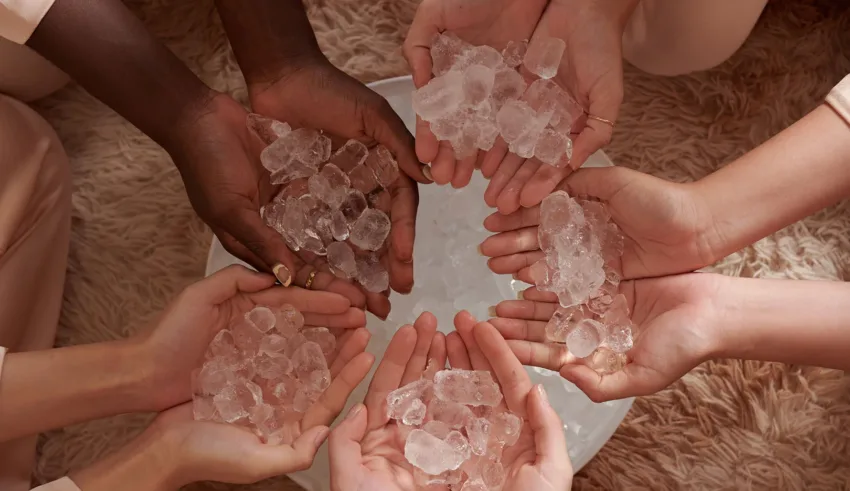
In the world of skincare, new trends, and techniques are constantly emerging, each promising to deliver youthful, radiant skin. Facial icing is one such trend that has attracted attention in recent years. This simple but intriguing practice involves using ice or ice water to cool the skin, and its proponents claim it has a multitude of benefits. But does facial icing really live up to its promise? In this article from The Dermo Lab, we delve into the science behind face icing and explore whether it is a valuable addition to your skincare routine.
What are the origins of face icing?
The origins of facial icing can be traced back to ancient skin care practices in various cultures. Although the exact origin is difficult to determine, historical evidence suggests that cooling techniques have been used for centuries to enhance skin health and beauty.
The use of jade rollers in ancient China is a striking example. Jade, a cold stone, was said to have healing properties and was used to massage and refresh the skin. The rolling motion of the jade roller, combined with its cooling effect, was said to promote circulation, reduce puffiness and improve overall skin vitality.
In ancient Egypt, renowned for its emphasis on beauty and skin care, Egyptian queens and nobility are said to have used ice baths. These ice baths were said to firm the skin, reduce inflammation and maintain a youthful appearance. Ice cubes were also applied directly to the skin to refresh and revitalize it.
Throughout history, various cultures have recognized the benefits of cold temperatures on the skin. These practices inspired the modern technique of facial icing, which has gained popularity as a simple and accessible method of achieving the desired effects on the skin.
What are the benefits of face icing?
1- Reduces puffiness and inflammation: Proponents of facial icing claim that the cooling effect helps to constrict blood vessels, thereby reducing puffiness and inflammation. Cold temperatures are said to restrict blood flow to the skin’s surface, reducing redness and swelling.
2- Shrinks pores: Another claim is that face icing can help reduce the appearance of pores. Proponents claim that cold temperatures cause the skin to contract, tightening pores and making them appear smaller.
3- Improves blood circulation: Facial icing is claimed to improve blood circulation when used in a gentle, massage-like motion. This increase in blood flow can deliver essential nutrients and oxygen to the skin, promoting a healthier complexion.
4- Improves product absorption: Some skincare enthusiasts believe that applying ice or cold water before using other skincare products can improve their absorption. The theory suggests that cooled skin temporarily tightens pores, allowing better penetration of active ingredients.
5- Soothes and refreshes: Applying ice or cold water to the face can provide a cooling sensation, soothing the skin and relieving discomfort. This can be particularly beneficial after a hot day or in hot weather.
6- Calms acne and redness: Face icing can help calm acne breakouts and reduce redness. The cold temperature can temporarily numb the skin, relieving the pain and inflammation associated with acne.
What scientific evidence supports the claimed benefits?
Although face icing has gained in popularity, it’s important to evaluate the scientific evidence supporting its claimed benefits. Although there is little research on face icing in particular, some aspects can be understood based on our knowledge of the skin and the effects of cold temperatures.
1- Swelling and inflammation: Cold temperatures can cause vasoconstriction, resulting in reduced blood flow and a potential reduction in puffiness and inflammation. However, the effects are likely to be temporary, and more severe swelling or inflammation may require medical intervention (1).
2- Pore size: Although cold temperatures can cause temporary pore constriction, there is no evidence that facial icing can permanently reduce pore size (2). The appearance of pores is mainly determined by genetics and skin type.
3- Circulation and product absorption: Gentle massage with a cold object can promote blood circulation in the superficial layers of the skin, producing a temporary plumping effect. However, the impact on nutrient supply and absorption of skincare products remains uncertain and may vary according to individual skin characteristics.
4- Acne and redness: Cold temperatures can have an anesthetic effect on the skin, temporarily relieving the pain and inflammation associated with acne (3). The sensation of cold can also help reduce redness by constricting blood vessels.
It’s important to recognize that while these scientific principles confirm the potential benefits of face icing, results may vary from person to person. The effects of facial icing can be subjective and influenced by factors such as skin type, specific concerns, and general skincare routine. Further scientific research specifically focused on face icing is needed to provide more concrete evidence of its alleged benefits.
What are the tips and tricks of this technique?
Facial icing can be easily incorporated into your skincare routine by following a few simple steps. Start by wrapping a few ice cubes in a soft cloth, or use a chilled facial roller. Gently glide the ice cube or roller over your face, focusing on areas prone to puffiness or inflammation. Take your time and apply gentle pressure to allow the cooling sensation to work its magic. For added relaxation and aromatherapeutic benefits, infuse the ice cubes or water with a few drops of your favorite facial oil or herbal extract.
Bottom line
Facial icing has become a popular skincare trend, with enthusiasts praising its ability to reduce puffiness, shrink pores, promote circulation, and improve product absorption. Although scientific research on facial icing is limited, cold temperatures may offer temporary benefits such as reduced inflammation and a tightening effect. However, it’s important to remember that results may vary from person to person, and that face icing should not replace a complete skin care routine or professional advice for specific skin problems. As with any new skin care practice, it’s advisable to proceed with caution, listen to your skin’s needs, and consult a dermatologist if necessary.








